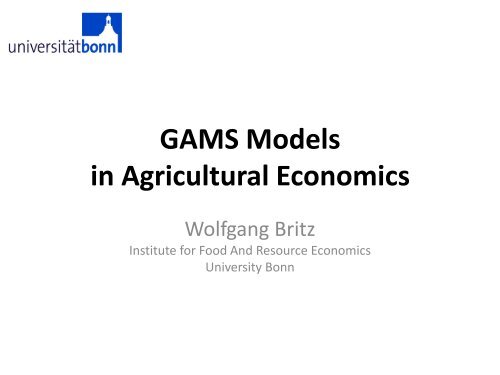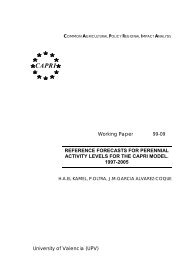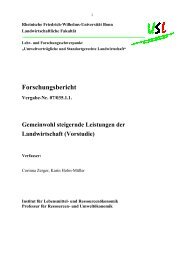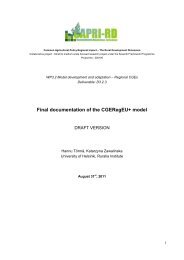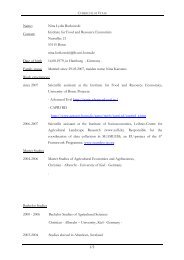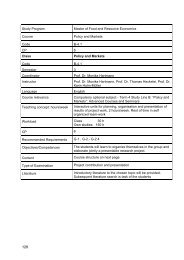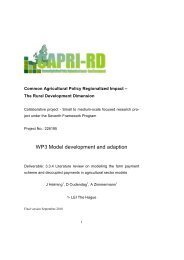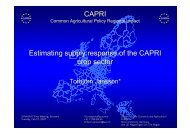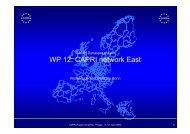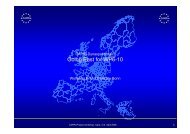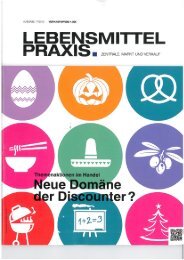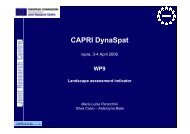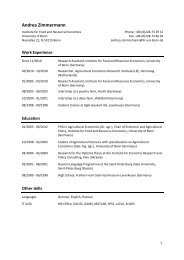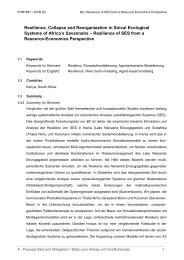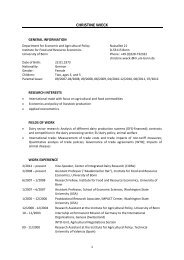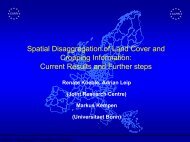GAMS Models in Agricultural Economics
GAMS Models in Agricultural Economics
GAMS Models in Agricultural Economics
You also want an ePaper? Increase the reach of your titles
YUMPU automatically turns print PDFs into web optimized ePapers that Google loves.
<strong>GAMS</strong> <strong>Models</strong><br />
<strong>in</strong> <strong>Agricultural</strong> <strong>Economics</strong><br />
Wolfgang Britz<br />
Institute for Food And Resource <strong>Economics</strong><br />
University Bonn
Content<br />
• Simulation models <strong>in</strong> agricultural economics<br />
• CAPRI as an example: what, why and how<br />
• Why <strong>GAMS</strong>: features, costs, user community<br />
• Limitations of <strong>GAMS</strong><br />
• CAPRI GUI: wrapp<strong>in</strong>g <strong>GAMS</strong><br />
• Summary
Simulations models<br />
<strong>in</strong> agricultural economics<br />
• Long tradition:<br />
– 1950ties: LP based farm level optimization, today<br />
mostly MIP, fully dynamic, stochastic<br />
– 1970ties: application to „typical“ or „regional“<br />
farm for policy analysis<br />
– Branch dried out for a while due to typical<br />
problems of LPs (jumpy behaviour, overspecialization)<br />
and hunger for data not available<br />
from statistics
Simulations models<br />
<strong>in</strong> agricultural economics<br />
• 1980ties, price endogenous market models:<br />
– Multi-Commodity models:<br />
• Global simultaneous equilibrium for many agricultural<br />
products and many countries/country blocks<br />
• Prices, supply, demand and trade endogenous<br />
• Non-l<strong>in</strong>ear CNS or NCP<br />
– Computable General Equilibrium <strong>Models</strong>:<br />
• Simulatenous equilibrium for all markets <strong>in</strong> an economy<br />
(<strong>in</strong>put, outputs, primary factors)<br />
• Non-l<strong>in</strong>ear CNS or MCP
Simulations models<br />
<strong>in</strong> agricultural economics<br />
• Today:<br />
– Revival of programm<strong>in</strong>g models<br />
• <strong>in</strong>troduction of (econometrically estimated) non-l<strong>in</strong>earities<br />
eases calibration and avoids over-specialization<br />
• <strong>in</strong>creas<strong>in</strong>g focus on agri-environmental <strong>in</strong>teractions (bioeconomic<br />
modell<strong>in</strong>g)<br />
– All model types grow <strong>in</strong> resolution (products, space,<br />
agents) and complexity (policy <strong>in</strong>strument covered,<br />
functional forms, stochastics ..)<br />
– Comb<strong>in</strong>ation of different type of models <strong>in</strong>to tools for<br />
impact assessment
CAPRI<br />
• Common <strong>Agricultural</strong> Policy Regionalized<br />
Impact:<br />
– Tool for impact assessment of policies related to<br />
the agricultural sector<br />
– Clients: ma<strong>in</strong>ly EU commission, but also national<br />
government and <strong>in</strong>dustry<br />
– Comb<strong>in</strong>es economic models, match<strong>in</strong>g data bases,<br />
IT <strong>in</strong>frastructure and <strong>in</strong>stitutional sett<strong>in</strong>g<br />
– F<strong>in</strong>anced ma<strong>in</strong>ly by EU research framework<br />
programs and tenders
CAPRI as an example<br />
• Two modules, l<strong>in</strong>ks by sequential calibration<br />
– About 2000 farm type models with<br />
(each ~300 vars x ~200 equations, NLPs, <strong>in</strong>dependently<br />
solved as grid)<br />
– Global, spatial trade model for agricultural<br />
products<br />
( CNS, <strong>in</strong> parts highly non l<strong>in</strong>ear, 40.000x40.000)<br />
– One run solves each module ~20 times, ~20-30 m<strong>in</strong>utes,<br />
generates ~15 Mio non zeros, <strong>in</strong> parts post-model calculated<br />
economic and environmental <strong>in</strong>dicators
CAPRI as an example<br />
• Simulates impacts of policy <strong>in</strong>struments such as<br />
tariffs, subsidies, agri-environmental programs<br />
• On various <strong>in</strong>dicators such as<br />
– Crop areas, yields, herd sizes, production, feed use<br />
– Human consumption, <strong>in</strong>dustrial proces<strong>in</strong>g, trade flows<br />
– Farm <strong>in</strong>come, EU budget costs, consumer welfare<br />
– GHG emissions, nutrient balances<br />
• Developped end of the n<strong>in</strong>eties, s<strong>in</strong>ce then<br />
cont<strong>in</strong>ously expanded, improved and applied<br />
• Open source concept, network based
CAPRI <strong>in</strong> <strong>GAMS</strong><br />
• Complete work flow <strong>in</strong> <strong>GAMS</strong><br />
– Data base generation and model parameterization:<br />
• Mapp<strong>in</strong>g/aggregation/dis-aggregation of raw official data<br />
• Outlier detection and correction<br />
• Bayesian estimators to consilidate raw statistical data<br />
• Estimators for behavioural parameters<br />
– Generation of „market outlook“ (currently 2020)<br />
– Model calibration to outlook results<br />
– Simulation runs<br />
– Post model process<strong>in</strong>g, <strong>in</strong>clud<strong>in</strong>g statistical downscal<strong>in</strong>g<br />
to about 200.000 1x1 km clusters<br />
– Results are passed between worksteps via GDX
Why <strong>GAMS</strong>?<br />
• Developped orig<strong>in</strong>ally from economists for<br />
economists:<br />
– Notation comes close to scientific papers<br />
– Relatively easy to learn<br />
– Compact notation for element wise operations,<br />
avoids explicit loop and if statements<br />
– Transparent <strong>in</strong>terface to high performance solvers<br />
for different problem types: LP, NLP, MIP, CNS,<br />
MCP etc.
Why <strong>GAMS</strong>?<br />
• Basic IDE, sufficient for medium sized projects<br />
• Proprietary b<strong>in</strong>ary data format (GDX):<br />
– Fast, safes disk space, tailored for large sparse<br />
matrices, l<strong>in</strong>k e.g. to EXCEL<br />
– API support for high-level programm<strong>in</strong>g<br />
languages, provides bridge to DBMS or tailored<br />
GUIs<br />
• Cont<strong>in</strong>ous development e.g. support for new<br />
solvers
Why <strong>GAMS</strong>?<br />
• Relatively restricted language features<br />
– no functions/sub-rout<strong>in</strong>es<br />
– limited number of object classes (set, parameter,<br />
equation, variable, model, file ..)<br />
– all numbers are double precisions (not dist<strong>in</strong>ctions<br />
between <strong>in</strong>t, long, float, double etc.)<br />
– no explicit str<strong>in</strong>g handl<strong>in</strong>g<br />
– every symbol has global scope
Why <strong>GAMS</strong>?<br />
• Consequences of restricted language features:<br />
– no formal education <strong>in</strong> IT required – fits typical<br />
profile of (agr) economists<br />
– debugg<strong>in</strong>g is typical easy<br />
– low learn<strong>in</strong>g costs<br />
– dis-advantages for experienced programmers and<br />
large-scale projects
Why <strong>GAMS</strong>?<br />
• Trial version (often sufficient for didactic<br />
purposes) can be downloaded for free<br />
• Relatively modest license fees for degree<br />
grant<strong>in</strong>g <strong>in</strong>stitutions<br />
• Good manuals, active e-mail list<br />
• Long list of example models<br />
• Portable between platforms, can be used<br />
without GUI/IDE
Why <strong>GAMS</strong>?<br />
• Features expla<strong>in</strong> wide spread use <strong>in</strong><br />
community as a k<strong>in</strong>d of „l<strong>in</strong>gua franca“:<br />
– Thaught <strong>in</strong> courses at master level based on „toy<br />
models“, e.g. already <strong>in</strong> Germany by various agecon<br />
departments<br />
– Allows researchers to switch relatively easy<br />
between tools and <strong>in</strong>stitutions<br />
– Eases tool l<strong>in</strong>kage
Why <strong>GAMS</strong>?<br />
• Many other examples of policy relevant agecon<br />
models realized <strong>in</strong> <strong>GAMS</strong>, e.g.<br />
– Uni Hohenheim: ESIM<br />
– Univ. Wagen<strong>in</strong>gen, NL: farm type models<br />
– Texas A&M: FASOM<br />
– Penn state: PEATSIM<br />
– Purdue: GTAP <strong>in</strong> <strong>GAMS</strong><br />
– ...
Limitations<br />
• Modular design and exchange of code<br />
between projects not easy:<br />
– Global scope of all symbols, only rudimentary<br />
support for functions/subrout<strong>in</strong>es<br />
namespace conflicts<br />
no encapsulation<br />
documentation is tedious<br />
Spaghetti<br />
code<br />
Each symbol global<br />
– IDE not ideal for large-scale projects compared<br />
e.g. with Eclipse
Limitations<br />
• So far no parallel execution <strong>in</strong> the base module<br />
and <strong>in</strong> some widely solvers such as CONOPT:<br />
– Multiple cores not used<br />
– Pre- and post model process<strong>in</strong>g <strong>in</strong>creas<strong>in</strong>lgy CPU<br />
bottleneck<br />
• Parallel model solves supported, but I/O <strong>in</strong>tensive<br />
– Little ga<strong>in</strong> for a suite of small model <strong>in</strong>tances<br />
– „hot“ updates <strong>in</strong> solvers <strong>in</strong> early stages, applicability<br />
not yet clear
CAPRI GUI<br />
• <strong>GAMS</strong> alone not appropriate to host complex<br />
tools, CAPRI e.g. should allow<br />
– users to easily def<strong>in</strong>e, start and exploit own<br />
scenarios (if possible without touch<strong>in</strong>g <strong>GAMS</strong><br />
directly)<br />
– adm<strong>in</strong>istrators to steer support<strong>in</strong>g work steps<br />
(such as data base and outlook generation,<br />
calibration), best without cod<strong>in</strong>g<br />
– efficiently analysis of huge data sets
CAPRI GUI<br />
• CAPRI responded by develop<strong>in</strong>g its own GUI<br />
– Realized <strong>in</strong> Java<br />
– Steers <strong>GAMS</strong> work steps by generat<strong>in</strong>g „code<br />
snippets“ and spawn<strong>in</strong>g <strong>GAMS</strong><br />
– comprises powerful exploitation tools (reports as<br />
tables, graphs, maps) to analyze results<br />
– access to <strong>GAMS</strong> generated data via API bridge to<br />
GDX
CAPRI GUI<br />
Switch<br />
modules<br />
on/off<br />
What to<br />
do (step<br />
& task)<br />
Post-model<br />
report<strong>in</strong>g<br />
options<br />
Start <strong>GAMS</strong>
CAPRI GUI<br />
Work step is runn<strong>in</strong>g …<br />
(GUI has spawned <strong>GAMS</strong>)<br />
<strong>GAMS</strong><br />
output redirected to GUI
CAPRI GUI<br />
After the run:<br />
Exploit results …<br />
Chose<br />
several<br />
scenarios
CAPRI GUI<br />
Pre-def<strong>in</strong>ed reports<br />
(tables, graphs, maps)<br />
Allows for pivot, selections,<br />
comparisons etc. …
CAPRI <strong>in</strong> <strong>GAMS</strong><br />
• Further <strong>GAMS</strong> related GUI features:<br />
– Generation of HTML based documentation of<br />
<strong>GAMS</strong> files à la Javadoc<br />
– Batch process<strong>in</strong>g mode (check of all work steps<br />
after code changes, runn<strong>in</strong>g packages of<br />
scenarios)<br />
– Meta data generation/handl<strong>in</strong>g (are stored along<br />
with numerical results <strong>in</strong> GDX files)
Summary<br />
• <strong>GAMS</strong> has currently high market share for<br />
agricultural economic simulation models<br />
• Probable reasons<br />
– Ease of use and conv<strong>in</strong>c<strong>in</strong>g basic concept<br />
– Transparent l<strong>in</strong>k to solvers<br />
– Relatively low cost<br />
– Exist<strong>in</strong>g market penetration<br />
• Larger projects wrap <strong>GAMS</strong> <strong>in</strong> applications
Outlook<br />
• Future market share of <strong>GAMS</strong> might depend on:<br />
– Further performance ga<strong>in</strong>s (parallel execution, „hot“<br />
solver updates, ...)<br />
– Comb<strong>in</strong><strong>in</strong>g the appeal<strong>in</strong>g simple concept with more<br />
advanced features such as scop<strong>in</strong>g, object oriented<br />
design, functions/subrout<strong>in</strong>es ... but how?<br />
– Add<strong>in</strong>g functionalities such as automated generation<br />
of project code documentation or l<strong>in</strong>k to SVN<br />
– Development of alternatives such as libraries <strong>in</strong> Object<br />
Oriented Languages (Java, C#) , already now applied<br />
for some newer methodologies such as Agent Based<br />
Modell<strong>in</strong>g
Thanks for your attention<br />
more on CAPRI<br />
www.capri-model.org<br />
contact author<br />
Wolfgang.Britz@ilr.uni-bonn.de


